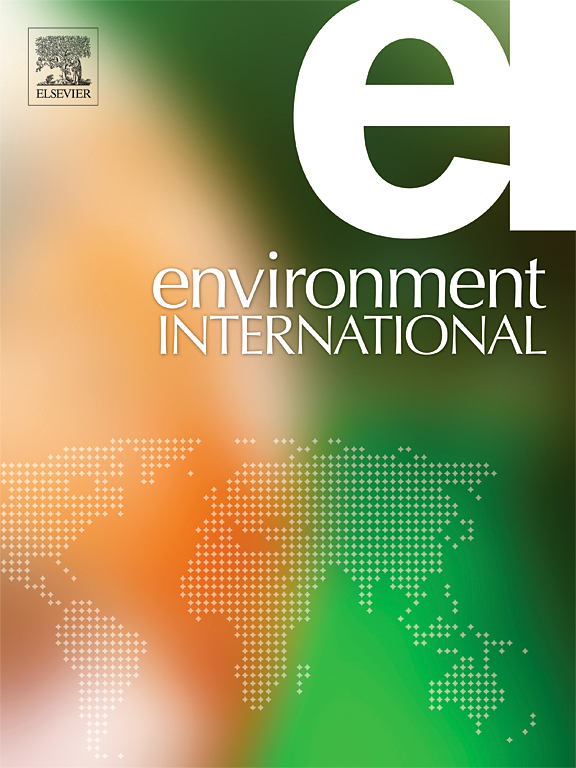城市水系中全氟磺酸短链优势及其环境运输动态:来自多媒体运输分析和人类暴露风险的见解
IF 9.7
1区 环境科学与生态学
Q1 ENVIRONMENTAL SCIENCES
引用次数: 0
摘要
由于短链全氟烷基和多氟烷基物质(PFASs)的持久性、高流动性和广泛存在,它们的日益流行给城市水系统(UWS)带来了重大挑战。本研究全面评估了受工业活动影响的UWS中PFASs的发生、环境迁移、影响因素、去除效率和人类健康风险。对长链PFASs的监管限制导致它们被短链类似物所取代,导致它们在制造工厂园区(mpp)的废水中占主导地位,浓度范围为30.28至3738.51 ng/L(平均值:557.68 ± 1072.03 ng/L)。污水处理厂(WWTP)同时是PFASs的源和汇,平均去除率为负(-47.4 %),估计每年向环境中排放12.29 kg的PFASs。在污水处理厂下游,由于稀释和泥沙分配,河流中PFASs浓度呈指数级下降;然而,短链PFASs由于其高水性迁移率,可以在长距离中持续存在。虽然在河流中检测到的全氟化砷含量对人类健康构成低风险,但对水生生物,特别是藻类、无脊椎动物和鱼类构成低至中等生态风险。采用分段结构方程模型(piecewiseSEM)和共发生网络分析(CNA)的高级统计分析确定了全氟磺酸行为的关键环境驱动因素,包括重金属(效应值:0.70)、营养水平(0.36)和物理化学参数(-0.52)。此外,饮用水处理厂(dwtp)的去除效率有限,自来水浓度在27.95至84.72 ng/L之间,超过了美国环保署(2022年)(PFOA: 0.004 ng/L, PFOS: 0.02 ng/L)和加拿大卫生部(Σ25PFAS: 30 ng/L)设定的监管限值。这些发现强调,迫切需要加强监管,开发可持续替代品,并实施先进的处理技术,以减轻与短链全氟辛烷磺酸相关的环境和公共健康风险。本文章由计算机程序翻译,如有差异,请以英文原文为准。


Short-chain PFASs dominance and their environmental transport dynamics in urban water systems: Insights from multimedia transport analysis and human exposure risk
The increasing prevalence of short-chain per- and polyfluoroalkyl substances (PFASs) poses significant challenges for urban water systems (UWS) due to their persistence, high mobility, and widespread occurrence. This study provides a comprehensive assessment of the occurrence, environmental transport, influencing factors, removal efficiency, and human health risks of PFASs across UWS impacted by industrial activities. Regulatory restrictions on long-chain PFASs have led to their replacement with short-chain analogues, resulting in their dominance in effluents from manufacturing plant parks (MPPs), with concentrations ranging from 30.28 to 3738.51 ng/L (mean: 557.68 ± 1072.03 ng/L). Wastewater treatment plant (WWTP) serve as both sources and sinks of PFASs, with a negative average removal efficiency (–47.4 %) and an estimated annual discharge of 12.29 kg of PFASs into the environment. Downstream of WWTP, PFASs concentrations in rivers decrease exponentially due to dilution and sediment partitioning; however, short-chain PFASs persist over long distances due to their high aqueous mobility. While the detected PFAS levels in rivers pose low health risks to humans, they present low to medium ecological risks to aquatic organisms, particularly algae, invertebrates, and fish. Advanced statistical analyses using piecewise structural equation modeling (piecewiseSEM) and co-occurrence network analysis (CNA) identified key environmental drivers of PFASs behavior, including heavy metals (effect size: 0.70), nutrient levels (0.36), and physicochemical parameters (–0.52). Furthermore, drinking water treatment plants (DWTPs) demonstrated limited removal efficiency, with tap water concentrations ranging from 27.95 to 84.72 ng/L, exceeding the regulatory limits set by the US EPA (2022) (PFOA: 0.004 ng/L, PFOS: 0.02 ng/L) and Health Canada (Σ25PFAS: 30 ng/L). These findings underscore the urgent need for enhanced regulations, the development of sustainable alternatives, and the implementation of advanced treatment technologies to mitigate the environmental and public health risks associated with short-chain PFASs.
求助全文
通过发布文献求助,成功后即可免费获取论文全文。
去求助
来源期刊

Environment International
环境科学-环境科学
CiteScore
21.90
自引率
3.40%
发文量
734
审稿时长
2.8 months
期刊介绍:
Environmental Health publishes manuscripts focusing on critical aspects of environmental and occupational medicine, including studies in toxicology and epidemiology, to illuminate the human health implications of exposure to environmental hazards. The journal adopts an open-access model and practices open peer review.
It caters to scientists and practitioners across all environmental science domains, directly or indirectly impacting human health and well-being. With a commitment to enhancing the prevention of environmentally-related health risks, Environmental Health serves as a public health journal for the community and scientists engaged in matters of public health significance concerning the environment.
 求助内容:
求助内容: 应助结果提醒方式:
应助结果提醒方式:


